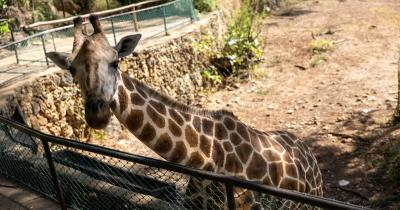
 Kenyan zoo captive giraffe/Photo Credit/World Animal Protection Kenya/FILE
Kenyan zoo captive giraffe/Photo Credit/World Animal Protection Kenya/FILEA new report has exposed how wild animals are being bred, confined and exploited in captive facilities across Kenya under the guise of conservation and tourism.
The animals include crocodiles, giraffes, ostriches, tortoises, monkeys and hippos.
The report, released by World Animal Protection, reveals how wildlife is illegally extracted from the wild and exported as though it were captive-bred, a practice contributing to biodiversity loss.
The report titled 'Behind Bars: Lifting the Lid off Kenya’s Cruel Wildlife Farming', is based on months of undercover field investigations and research.
According to the findings, every facility investigated showed serious animal welfare concerns, including overcrowding, untreated injuries, parasite infestations, poor nutrition and severe stress behaviours. The report further pointed out shocking animal cruelty, threats to public health and the risk of damaging Kenya’s global conservation reputation.
On public health, the report found that some tourist venues allowed close human–animal contact and lacked even basic hygiene measures such as hand-washing, raising the risk of zoonotic disease transmission.
The study also showed captive farming undermines conservation efforts. Field visits confirmed that animals were being illegally taken from the wild and laundered through legal systems as though born in captivity.
Tennyson Williams, director for Africa at World Animal Protection, urged the Ministry of Tourism and Wildlife and the Kenya Wildlife Service to take leadership in ending the exploitation of wild animals.
“Kenya has the opportunity to address these gaps, especially now that the country is in the process of developing a new wildlife law, currently at Bill stage,” he said.
Edith Kabesiime, wildlife campaign manager at World Animal Protection, said the findings confirm wildlife farming in Kenya is driven by profit, not conservation.
“The illegal aspects of this exploitation are very worrying. This report sheds light on the suffering endured by farmed wild animals, exposing laundering of species through legal systems, and the urgent need for policy change,” she said.
The organisation is urging the government to immediately prosecute and shut down exploitative facilities, enforce a moratorium on the expansion of captive wildlife farming, and ban visitor interactions such as hand-feeding and petting of wild species.
The report warned that wildlife farming is not a sustainable solution for Kenya or any other country, as it perpetuates animal suffering, undermines conservation and poses serious public health risks.
“The Kenyan government, private sector and
individuals must come together to end this practice and ensure wild
animals are protected in their natural environments,” the report concludes.












